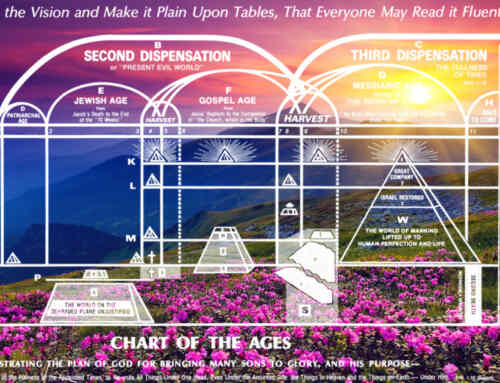The New Testament was written in the Greek language, and it is much more precise than English. There are multiple Greek words, each with their own unique meaning, that have all been translated as the same English word “coming.” So when we try to look into prophesies to discover whether or not our Lord’s “coming” is near, it is important first to understand which word is being used.
The first Greek word that we would like to examine is parousia, which really means “present”. This same word is used in other verses which can help us understand its meaning. 2 Corinthians 7:6-7 talks about how they were comforted “by the coming
Some think of his second advent as an event when Jesus arrives to pronounce judgment. However, this word parousia is used to describe a whole time period before he makes himself known to all. It is a time when he is invisibly present, preparing the world for his manifestation.
Let us look at some prophesies meant to help us know how this presence happens.
I Thess. 5:2, “for you know very well that the day of the Lord will come like a thief in the night.” We don’t know when it will happen until it is happening. No one can know the day or hour. That’s why we need to be watching and praying.
In Luke 17:20-23, Jesus tells the Pharisees that the kingdom of heaven is not something that can be observed. The idea is that we should not be looking for it with our physical eyes. Luke 17:22-23 has a similar thought “Those days will come when you will desire to behold one of the days of the Son of man, and you will not see it. And they will say to you ‘See here’ or ‘See there,” go not after them.” The Greek words translated “see” in these verses imply a visible manifestation, which Jesus says is inaccurate.
In Matt 24:3, the disciples ask Jesus what will be the signs that he is present. It is interesting to note that if the disciples understood that they would be able to physically see him as soon as he came, they would certainly not need any signs to know that he is present. And yet Jesus answers them with a full chapter. Additionally, when Jesus first appeared after his resurrection, his mother and his disciples did not recognize him, even by looking right at him. Only by some mannerism or sign did they realize that it was him. Just like them, we will not be able to find Jesus by looking at him, but by the signs that he gave us specifically for that purpose.
These signs are given to us in Matthew 24 and in Luke 17. They are prophetic, so they can be difficult to understand. One key prophesy is the “gospel of the kingdom shall be preached in all the world for a witness unto all nations; and then shall the end come.” Today, the full Bible has been translated into 531 languages. Key parts of the Bible are in 2,883 languages. Never before has the gospel been so wide spread. It has certainly been a witness in all the world.
Another prophesy comes from Matt 24:32-33, “Now learn this lesson from the fig tree: As soon as its twigs get tender and its leaves come out, you know that summer is near. Even so, when you see these things, you know that it is near, right at the door.” The previous day, Jesus had cursed the fig tree because it had no fruit, even though it had leaves (see Matt 21:18-19 and Mark 11:12-14, 20-21). It is commonly accepted that the fig tree represents the nation of Israel in scripture. When Jesus cursed the fig tree, he was really cursing the nation for not accepting the Messiah. Israel was then destroyed and the Jews dispersed. But the prophesy in Matt 24 tells us that when leaves begin to come out on the fig tree again, Jesus is right there (present). After nearly 2,000 years, Israel became a nation again in 1948. This would indicate that the fig tree is beginning to put out leaves again, hence our Lord is present.
So in looking at the prophesies for how to know when our Lord is present (and we only touched on two), we can tell that they are describing current events, indicating that our Lord is present. However, he is obviously not yet visible to the rest of the world. There is another greek word, epiphaneia, which means an appearing or manifestation, and yet another word, apokalupto, which means that something has been disclosed, made known, or uncovered. These indicate a future time when Jesus will make his presence known. It is this time that comes to mind when talking about Jesus’ “coming,” even though many of the instances in scripture refer to the time right before – now.
So when you think of the word, parousia, think of invisible presence. Jesus is making preparations to reveal himself to the world. The events that are taking place during this phase are the tearing down of the world’s kingdoms. Before he can set up his new, perfect kingdom, he must first destroy all the worldly governments and political, economic and social powers that are in place. This makes sense knowing that most of the prophesies dealing with his presence are related to tribulation and hardship. But as soon as his preparation is complete and the world is ready for his kingdom to be set up, he will become manifest or reveal himself. This revealing will happen soon! Matt 24:34 says that “this generation will not pass away until all these things have happened.”
So yes, the coming of the Lord is very near, but it comes through a period of great tribulation when he is actually “present.” The good news for us is that as we watch the nation’s unrest, we can put away our anxiety and know that Jesus is accomplishing a great task that will culminate in a beautiful kingdom of righteousness!



















